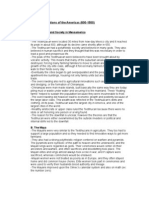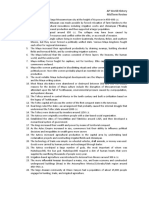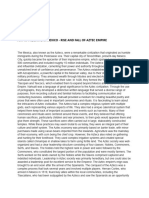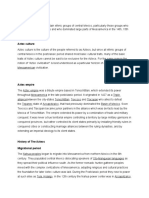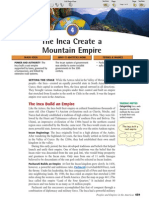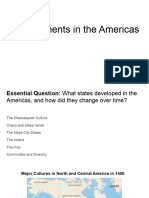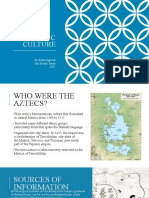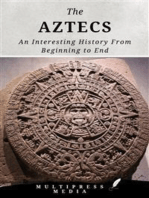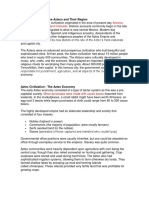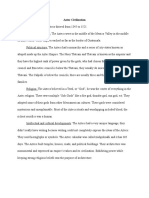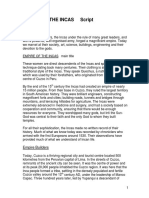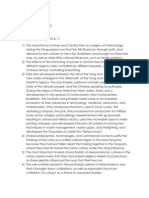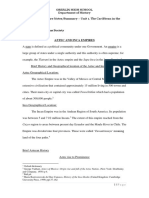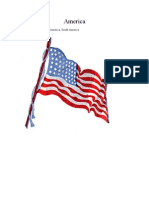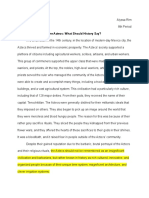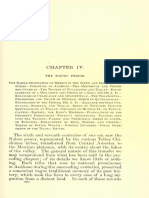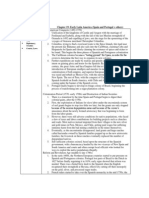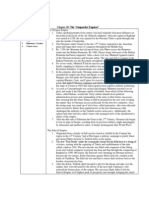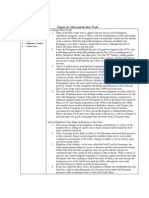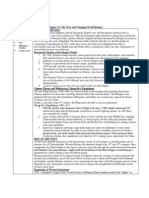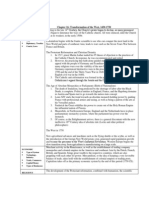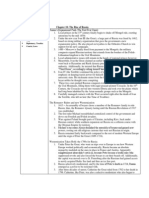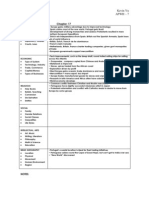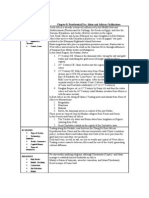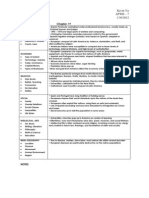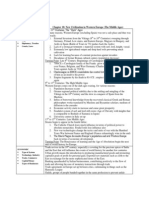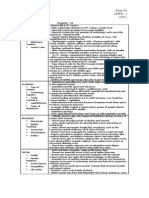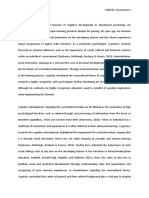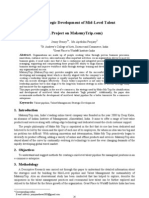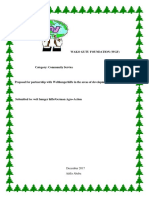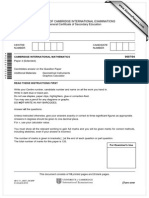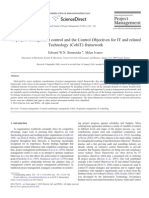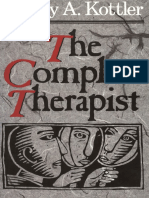Andrew Yang Persian Chart Period 7 AP World History Chapter 11: The Americas On The Eve of Expansion
Andrew Yang Persian Chart Period 7 AP World History Chapter 11: The Americas On The Eve of Expansion
Uploaded by
apwhhchsCopyright:
Available Formats
Andrew Yang Persian Chart Period 7 AP World History Chapter 11: The Americas On The Eve of Expansion
Andrew Yang Persian Chart Period 7 AP World History Chapter 11: The Americas On The Eve of Expansion
Uploaded by
apwhhchsOriginal Title
Copyright
Available Formats
Share this document
Did you find this document useful?
Is this content inappropriate?
Copyright:
Available Formats
Andrew Yang Persian Chart Period 7 AP World History Chapter 11: The Americas On The Eve of Expansion
Andrew Yang Persian Chart Period 7 AP World History Chapter 11: The Americas On The Eve of Expansion
Uploaded by
apwhhchsCopyright:
Available Formats
Andrew Yang PERSIAN Chart Period 7 AP World History
POLITICAL Leaders, Elites
State Structure War
Diplomacy, Treaties Courts, Laws
Chapter 11: The Americas on the Eve of Expansion The Mesoamerican Postclassical civilizations start from where the Mayans abandoned their city centers in the 8th Century CE. The Toltec sweep in to fill the power vacuum (Teotihuacan falls). Focus of political power shifts to the central valley region and lakes of Mexico. 968CE = Toltec capital of Tula est. Empire extends over much of Central Mexico, with an influence extending into Mayan lands. c.1000CE = conquering of Chichen Itza Turning Point: 1150CE is the sacking of Tula and downfall of the Toltec For another 180 years many city states and tribes vie for control of the region; I. The Aztecs The Aztecs unexpectedly seep into the region and consolidate a hold by founding Tenochtitlan in the middle of Lake Texcoco around 1325CE. By 1428 CE = the Aztecs dominate the political situation 1434 CE = Triple Alliance between Texcoco, Tenochtitlan, and Tlacopan (Aztecs get the lions share of the benefits and territory) Tenochtitlan grows along with other Aztec cities, eventually having a population of about 150,000 people and occupying 5 sq miles of land by the time of Cortes invasion in 1519CE; population estimates of the whole empire are suggested at 20 million people at the peak of empire Internal strife was common and served as a major factor for Aztec weakness against the Spanish conquistadors. The empire was not really a very unified state but more based on tribute payments (inversely related to the degree of rebellion in the conquered territory) intended to intimidate and coerce into political submission; rebellions are harshly put down II. The Inca From the Andean cultural hearth, after the breakup of many large states such as the Huari and Tiahuanaco c.550 1000CE, there is also a power vacuum in which various regional kingdoms and chiefdoms vie for economic and political power (Moche valley kingdoms and the civilizations in and around Lake Titicaca); the state of Chimor with capital of Chan Chan emerges from the power struggle as the strongest political power in the region(900-1465CE) From the southern Andean highlands, Quechuan speaking clans (ayllus, much like a calpulli) living near Cuzco supposedly from legend come out of caves and come out to settle Cuzco by 1350CE 1438CE = Inca Pachacuti (1438 1471CE) begins a series of military campaigns that conquer Chimor and consolidate control over Lake Titicaca and the regions surrounding Cuzco. Thus, his successors continue on an endless set of campaigns to conquer territories to continue the practice of split inheritance, where the heir got the power but the king kept his land and wealth to himself.(Very unlike the Aztec drive for conquest that was centered on getting sacrificial victims) By 1527CE, his successors Topac Yupanqui, and Huayana Capac consolidate a large empire stretching from Ecuador to southern Chile; internal strife rock the empire apart and opens the way for Pizarro to conquer Inca Empire is highly structured with a noble bureaucracy and a series of local rulers pledging allegiance, as well as governors of the 4 provinces of the empire that were handpicked by the king himself (a mix of centralized and decentralized government that is similar to the tribute system of the Aztecs)
ECONOMIC Type of System
Technology, Industry Trade, Commerce Capital/Money Types of Businesses
Depended upon traditional forms of agriculture; the land was appropriated and food was demanded as tribute payment from conquered peoples; as a result, great surpluses of maize, corn, cotton, etc were brought into the capital city Tenochtitlan The chinampas system of irrigation, in which artificial islands of reeds were created to grow plants on and allow water to seep into faster, enables 4 harvesting seasons a year; dikes kept the freshwater separate from the brackish water of the southern portion of the lake. Tenochtitlan is at the center of a huge trade route that indicates contact with the Anasazi through the Turquoise trade route and even possibly an influence on the Hopewell of the Mississippi and Ohio River valleys through the arrival of huge pyramid mound structures in present day Illinois. Food was produced by the peasant farmers; local clans apportioned lands; the state controlled the distribution and accumulation of resources (a primitive form of socialism). Same situation with the Inca, in which the state controlled the distribution and flow of resources, except that the Inca were very self sufficient people and did not rely so much on trade Religion was a vast, unifying, sometimes oppressive force with a n emphasis on the fusion of earth and the religious realm At least 128 major deities, each with a female partner are venerated, and each god has many manifestations; certain gods become patron gods of city states; religious festivals and feasts each year are held to honor the gods Three Cults of Gods: 1. Fertility and Agriculture Deities Tlaloc, the god of rain, and other gods and goddesses of maize, water, and fertility 2. Creator Deities (gods of The Sun, an energetic driving force powered by human sacrificial blood , such as Tonatiuh, god of the Sun and Tezcatlipoca, god of night 3. Warfare and Human Sacrifice = Huitzilopochtli, the supreme deity in the eyes of the Aztec, and Quetzalcoatl, the feathered serpent/creator god/second most important deity The nourishment of the gods is the precious water of human blood; the world is powered by the gods and without blood for offerings, the world will collapse on itself and be destroyed (special Temple at Tenochtitlan) Incan religion is much the same, with human sacrifice also an important part of the religion and the sun god worshipped more A supreme ruler with wide powers emerges from a loose association of clans (social stratification) Tlacaelel is the central figure behind the change (1427-1480CE), rewriting the histories of the Aztecs and expanding the rite of human sacrifice to an enormous cult pushed by military conquests and flower wars; the king represents the civil and religious power(a bridge to the gods) There are originally 7 clan groups each called calpullis that were organized into residential districts and had their own functioning units that controlled recruitment of soldiers and maintenance of temples; much of the local life is based upon the calpulli; the family heads of each calpulli from governing councils , and the noble class emerges from the leaders of the calpulli, inheriting high office and controlling almost everything in terms of religious, political , and economic power with their estates. The class lower than the nobles are the rare merchant and artisan classes who can also spy for the Great Speaker, or emperor, and below them are the peasants, serfs, and slaves from conquered areas.
RELIGIOUS Holy Books
Beliefs, Teaching Conversion Sin/Salvation Deities
SOCIAL
Family Gender Relations Social Classes Inequalities Life Styles
Although women are restricted to household duties, they can pass on and even inherit land, an anomaly not seen in the rest of the world; marriages were arranged. The Incas possess much the same process of social stratification as territory was consolidated. Much time was consumed by lower classes concerning the grinding of maize and preparation of it for eating; NO wheel = NO sophisticated technology as in machines = NO real social development among the lower class; however, there is an abundance of art portraying the gods and human sacrifices, as well as ornately built temples and pyramids dedicated to gods Much religious and philosophical though is put into contemplating the importance of the gods in the creation of the universe and lifes questions about the existence of man Religious calendar reflects the cyclical nature of history and the destruction of the Earth (as in the great extinctions that occurred over the slow course of Earth history) A continuation of Mesoamerican art and intellectual information (star charts, religion, the calendar, etc) The Incas are well known for their advanced irrigation system involving terraces on the Andean Highlands; there was a huge extensive system of roads made of twisted rope fibers spanning gorges and mountain passes, some of which are still functional to this day. Incan buildings possess great workmanship and display great labor, because there was a lack of masonry in the Andean highlands (the walls have so few cracks that one cannot even chip at the wall with a knife and create a hole), especially in the ruins of Machu Picchu. Impressive system of supply centers and rest stops set up along the empires more than 3000 mile long territory called tambos. Incan counting system , or quipu, consists of a system of rods and dots that resembled an abacus type system The Americas are geographically isolated from the hotbeds of cultural contact and borrowing between Arabs, Crusaders, and African traders in the Postclassical era. Considering this, it is quite an accomplishment for the Aztecs and Incas to establish great empires with no help from anyone but their predecessor civilizations and with a lack of the resources such as the wheel and a scarcity of pack animals that were found so commonly in Eurasia and Africa.
INTELLECTUAL, ARTS Art, Music
Writing, Literature Philosophy Math & Science Education
NEAR: GEOGRAPHY Location
Physical Movement Human/Environme Region
nt
NOTES: The other Indians compromised of a diverse bunch of hunter gathering and agriculture based societies that developed some political and social hierarchies. But their role in shaping civilization in the Americas was minimal compared to the two great empires of the Aztec and Inca; both empires built upon the success of their ancestor civilizations, modifying their histories to glorify their people. They left behind
You might also like
- 6th Grade Reading ComprehensionDocument49 pages6th Grade Reading Comprehensioncontrùng đen100% (2)
- The Earth and Its Peoples: Chapter 12 OutlineDocument3 pagesThe Earth and Its Peoples: Chapter 12 OutlineeLLeeeN33No ratings yet
- Chapter 11 Outline Peoples and Civilizations of The Americas (600-1500)Document4 pagesChapter 11 Outline Peoples and Civilizations of The Americas (600-1500)Ferrari100% (9)
- The Aztec CultureDocument4 pagesThe Aztec CultureDiana LuciaNo ratings yet
- The AztecsDocument5 pagesThe Aztecsmuhammad alfarabyNo ratings yet
- Guided Reading Chapter 11Document3 pagesGuided Reading Chapter 11shalimi21No ratings yet
- The Untold Story of the Conquest of Tenochtitlan: From Hernán Cortés' Arrival to the Fall of the Aztecs – The Conquest of AmericaFrom EverandThe Untold Story of the Conquest of Tenochtitlan: From Hernán Cortés' Arrival to the Fall of the Aztecs – The Conquest of AmericaNo ratings yet
- Compare and Contrast Maya, Aztec, and IncaDocument4 pagesCompare and Contrast Maya, Aztec, and IncaranastarlaxNo ratings yet
- The Aztec EmpireDocument4 pagesThe Aztec EmpireIlinca DinuNo ratings yet
- Ap World History Midterm ReviewDocument4 pagesAp World History Midterm ReviewNathaly FierroNo ratings yet
- AP World History Chapter 11Document9 pagesAP World History Chapter 11Sandy Sandri100% (1)
- Persian Ky - 11Document2 pagesPersian Ky - 11apwhhchsNo ratings yet
- Precol EmpiresDocument26 pagesPrecol EmpiresedNo ratings yet
- Mexico MDocument2 pagesMexico MJan IsaacNo ratings yet
- Aztecas 15Document2 pagesAztecas 15caritoalfageme77No ratings yet
- Reading Guide ANSWERS Chapter 11Document5 pagesReading Guide ANSWERS Chapter 11Rishik ReddyNo ratings yet
- AztecDocument5 pagesAztecDaniel Karunia WijayaNo ratings yet
- Developments in The AmericasDocument26 pagesDevelopments in The Americasapi-690086282No ratings yet
- North American CivlizationDocument3 pagesNorth American Civlizationanon_205532No ratings yet
- The AztecsDocument2 pagesThe AztecsNeri100% (1)
- Aztec, Mixtec and Zapotec ArmiesDocument49 pagesAztec, Mixtec and Zapotec ArmiesFrancisco Diaz Pantaleón93% (14)
- AztecsDocument2 pagesAztecsAnand BijudasNo ratings yet
- 6history ReferenceSheet Unit1Document2 pages6history ReferenceSheet Unit1Ann-Sarah DayNo ratings yet
- CH 16 Sec 4 - The Inca Create A Mountain EmpireDocument5 pagesCH 16 Sec 4 - The Inca Create A Mountain EmpireMrEHsiehNo ratings yet
- Late Postclassic CulturesDocument33 pagesLate Postclassic CulturesilovearkNo ratings yet
- Chapter 11: Peoples and Civilizations of The Americas, 600-1500 Thesis: I. Classic-Era Culture and Society in Mesoamerica, 200-900 A. TeotihuacanDocument4 pagesChapter 11: Peoples and Civilizations of The Americas, 600-1500 Thesis: I. Classic-Era Culture and Society in Mesoamerica, 200-900 A. TeotihuacanlillianNo ratings yet
- Developments in The Americas SupplementalDocument22 pagesDevelopments in The Americas Supplementalapi-690086282No ratings yet
- Chapter 16Document28 pagesChapter 16api-206809924No ratings yet
- KulmarDocument14 pagesKulmarraulNo ratings yet
- Elegant Planner Cover DesignDocument8 pagesElegant Planner Cover DesignNatasha NaveedNo ratings yet
- Aztec Culture: by Peehu Agrawal and Tarushi Jhamb Xi-FDocument20 pagesAztec Culture: by Peehu Agrawal and Tarushi Jhamb Xi-FpeehuNo ratings yet
- Battle of the PhilippineDocument20 pagesBattle of the Philippine2008hadNo ratings yet
- AztecsDocument8 pagesAztecsgeaswaranNo ratings yet
- AZTECSDocument19 pagesAZTECSElisabet DubonNo ratings yet
- Aztec CivilizationDocument2 pagesAztec CivilizationCyntia PasillasNo ratings yet
- Mesoamerica: Where Civilizations Flourished, and Crashed, RepeatedlyDocument8 pagesMesoamerica: Where Civilizations Flourished, and Crashed, RepeatedlyEnvyAmarr •No ratings yet
- Mesoamerican Civilizations LinedDocument24 pagesMesoamerican Civilizations Linedshielamaygo05No ratings yet
- Fullerk AztecDocument2 pagesFullerk Aztecapi-352773858No ratings yet
- AztecDocument112 pagesAztecsorinNo ratings yet
- Chapter 8 Powerpoint- Pre Columbian AmericaDocument7 pagesChapter 8 Powerpoint- Pre Columbian Americaj6xszzd9vnNo ratings yet
- Pre-Columbian Cultures: See AlsoDocument5 pagesPre-Columbian Cultures: See AlsoBorisNo ratings yet
- Empire of The Incas ScriptDocument9 pagesEmpire of The Incas ScriptErickRojasNo ratings yet
- The AztecsDocument5 pagesThe AztecsAng RNo ratings yet
- 11 The Americas, 400-1500Document15 pages11 The Americas, 400-1500Jonathan Daniel KeckNo ratings yet
- Chinese Civilization PPT - ReviewerDocument33 pagesChinese Civilization PPT - ReviewerKrish D.No ratings yet
- Study Guide Chap 10&11 WHAPDocument4 pagesStudy Guide Chap 10&11 WHAPAudreyNo ratings yet
- Ancient Cultures of Central and South AmericaDocument24 pagesAncient Cultures of Central and South AmericatabithapangNo ratings yet
- STS Assignment MANGCADocument2 pagesSTS Assignment MANGCAJoshua MangcaNo ratings yet
- Inca Notes 1300 - 1541: A. Inca Timeline (4000 BCE - 1541 CE)Document8 pagesInca Notes 1300 - 1541: A. Inca Timeline (4000 BCE - 1541 CE)Suraj SidhuNo ratings yet
- AZTECSDocument8 pagesAZTECStaranfinaiusNo ratings yet
- Blood of The Gods From Religion to Human Sacrifice And CannibalismFrom EverandBlood of The Gods From Religion to Human Sacrifice And CannibalismNo ratings yet
- AZTEC AND INCA EMPIRES - PoliticalDocument6 pagesAZTEC AND INCA EMPIRES - PoliticalLeejiann DavidsonNo ratings yet
- 1-1-the-americasDocument12 pages1-1-the-americassamuel.l.jackson.bmfNo ratings yet
- America: North America, Central America, South AmericaDocument25 pagesAmerica: North America, Central America, South AmericaRizwan Nadeem100% (1)
- The Aztecs - What Should History SayDocument6 pagesThe Aztecs - What Should History Saywelcome hereNo ratings yet
- La Otra ConquistaDocument36 pagesLa Otra ConquistalzeeNo ratings yet
- Nahua: The Saw by America The What Each Anahuac Somewhat MiDocument52 pagesNahua: The Saw by America The What Each Anahuac Somewhat MiRussell HartillNo ratings yet
- Andrew Yang Period 7 Persian Chart AP World History Chapter 23: Industrial Revolution and Its Effects Intellectual Challenge and Population PressureDocument5 pagesAndrew Yang Period 7 Persian Chart AP World History Chapter 23: Industrial Revolution and Its Effects Intellectual Challenge and Population PressureapwhhchsNo ratings yet
- Andrew Yang Period 7 Persian Chart AP World History Chapter 22: Asian Transitions in An Age of Global ChangeDocument3 pagesAndrew Yang Period 7 Persian Chart AP World History Chapter 22: Asian Transitions in An Age of Global ChangeapwhhchsNo ratings yet
- Persian Ay - 19Document3 pagesPersian Ay - 19apwhhchsNo ratings yet
- Andrew Yang Period 7 Persian Chart AP World History Chapter 20: The "Gunpowder Empires"Document3 pagesAndrew Yang Period 7 Persian Chart AP World History Chapter 20: The "Gunpowder Empires"apwhhchsNo ratings yet
- Andrew Yang Period 7 Persian Chart AP World History Chapter 21: Africa and The Slave TradeDocument3 pagesAndrew Yang Period 7 Persian Chart AP World History Chapter 21: Africa and The Slave Tradeapwhhchs100% (1)
- Persian Ay - 15Document3 pagesPersian Ay - 15apwhhchsNo ratings yet
- Andrew Yang Period 7 Persian Chart AP World History Chapter 16: Transformation of The West, 1450-1750Document2 pagesAndrew Yang Period 7 Persian Chart AP World History Chapter 16: Transformation of The West, 1450-1750apwhhchsNo ratings yet
- Persian Ky - 22Document1 pagePersian Ky - 22apwhhchsNo ratings yet
- Andrew Yang Persian Chart AP World History Period 7 Chapter 18: The Rise of RussiaDocument2 pagesAndrew Yang Persian Chart AP World History Period 7 Chapter 18: The Rise of RussiaapwhhchsNo ratings yet
- Persian Ky - 17Document1 pagePersian Ky - 17apwhhchsNo ratings yet
- Andrew Yang Period 7 Persian Chart AP World History Chapter 17: The West and The WorldDocument2 pagesAndrew Yang Period 7 Persian Chart AP World History Chapter 17: The West and The WorldapwhhchsNo ratings yet
- Persian Ay - 8Document2 pagesPersian Ay - 8apwhhchsNo ratings yet
- Persian Ky - 20Document1 pagePersian Ky - 20apwhhchsNo ratings yet
- Persian Ky - 19Document1 pagePersian Ky - 19apwhhchsNo ratings yet
- Persian Chart Pre AP World History Chapter 6: Postclassical Era: Influences of IslamDocument2 pagesPersian Chart Pre AP World History Chapter 6: Postclassical Era: Influences of IslamapwhhchsNo ratings yet
- Persian Ay - 10Document2 pagesPersian Ay - 10apwhhchsNo ratings yet
- Persian Ky - 11Document2 pagesPersian Ky - 11apwhhchsNo ratings yet
- Persian Ay - 4Document3 pagesPersian Ay - 4apwhhchsNo ratings yet
- Persian Ay - 7Document2 pagesPersian Ay - 7apwhhchsNo ratings yet
- Persian Ky - 12Document2 pagesPersian Ky - 12apwhhchsNo ratings yet
- Persian Ky - 15Document1 pagePersian Ky - 15apwhhchsNo ratings yet
- Persian Ay - 5Document2 pagesPersian Ay - 5apwhhchsNo ratings yet
- Persian Ky - 14Document2 pagesPersian Ky - 14apwhhchsNo ratings yet
- Persian Ky - 6Document1 pagePersian Ky - 6apwhhchsNo ratings yet
- Persian Ky - 10Document2 pagesPersian Ky - 10apwhhchsNo ratings yet
- Persian Ky - 5Document2 pagesPersian Ky - 5apwhhchsNo ratings yet
- Topic 1 HBEF 3703Document25 pagesTopic 1 HBEF 3703szulkifli_14No ratings yet
- Chap 2 Defining Business EthicsDocument18 pagesChap 2 Defining Business Ethicsphuonganhvu0310No ratings yet
- Training Brochure: National Skill Training InstituteDocument4 pagesTraining Brochure: National Skill Training InstituteHot StarNo ratings yet
- Steps in Decision Making ProcessDocument2 pagesSteps in Decision Making ProcessPrasad IngoleNo ratings yet
- Expectancy Violations TheoryDocument19 pagesExpectancy Violations TheoryZaifirra FahannaNo ratings yet
- Bbar 403 SLMDocument231 pagesBbar 403 SLMprithvi.nesponNo ratings yet
- JACKSON Lauren EDN221 Assessment1Document8 pagesJACKSON Lauren EDN221 Assessment1Lauren JacksonNo ratings yet
- Homework Should Not Be Abolished SpeechDocument8 pagesHomework Should Not Be Abolished Speechafetuieog100% (1)
- Pre-Assessment or Diagnostic Assessment: Formative and Summative AssessmentsDocument3 pagesPre-Assessment or Diagnostic Assessment: Formative and Summative AssessmentsFaizal Usop PatikamanNo ratings yet
- Plant and Animal Cell OperationDocument8 pagesPlant and Animal Cell Operationapi-325015040No ratings yet
- Curriculum-Vitae: Asif KarimDocument2 pagesCurriculum-Vitae: Asif KarimASIF KARIMNo ratings yet
- Team Member Peer Evaluation Form: Ateneo Graduate School of BusinessDocument1 pageTeam Member Peer Evaluation Form: Ateneo Graduate School of BusinessTotie LumanglasNo ratings yet
- Anna Sukkerd 103Document5 pagesAnna Sukkerd 103Anna SukkerdNo ratings yet
- LL Graincorp: Offer Australia HoldingsDocument77 pagesLL Graincorp: Offer Australia HoldingsrguyNo ratings yet
- Training and Development ofDocument82 pagesTraining and Development ofBikramjeet Maan50% (2)
- Make My TripDocument5 pagesMake My TripPrasanth CoolNo ratings yet
- HandwashingDocument2 pagesHandwashingBonita MendozaNo ratings yet
- ICELT - Leaflet (2013) PDFDocument2 pagesICELT - Leaflet (2013) PDFMaksym BuchekNo ratings yet
- Feyera & CFID AgreementDocument21 pagesFeyera & CFID AgreementsimbiroNo ratings yet
- University of Cambridge International Examinations International General Certificate of Secondary EducationDocument20 pagesUniversity of Cambridge International Examinations International General Certificate of Secondary Educationvedant100% (1)
- School Education Department School Profile: For The Year 2010 - 11Document72 pagesSchool Education Department School Profile: For The Year 2010 - 11Dhina DhinakarNo ratings yet
- 1.3 Compare Experimental and Theoretical ProbabilityDocument14 pages1.3 Compare Experimental and Theoretical ProbabilityGaganpreet KaurNo ratings yet
- Bernroider & Ivanov (2010) - IT Project Management Control and The Control Objectives For IT and Related Technology (CobiT) FrameworkDocument12 pagesBernroider & Ivanov (2010) - IT Project Management Control and The Control Objectives For IT and Related Technology (CobiT) FrameworkChristian Søborg DehnNo ratings yet
- Sayeed Techno India UniversityDocument1 pageSayeed Techno India UniversityAlex DanverNo ratings yet
- The Compleat TherapistDocument234 pagesThe Compleat Therapistwilliam967100% (2)
- DL RequirementsDocument2 pagesDL RequirementsHnia UsmanNo ratings yet
- Orientation Prog On Communication SkillsDocument22 pagesOrientation Prog On Communication SkillsSrv Solitario BiswasNo ratings yet
- Humanities Class 11 Summer Holidays HomeworkDocument9 pagesHumanities Class 11 Summer Holidays HomeworkArun KumarNo ratings yet
- Autism Lesson Plan 1Document5 pagesAutism Lesson Plan 1api-283787251No ratings yet


